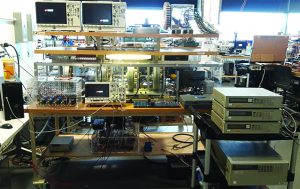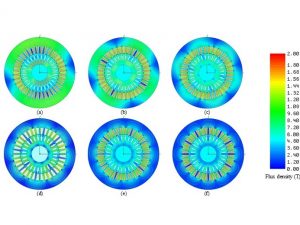I have no special talent. I am only passionately curious. — Albert Einstein
Our mission is to advance energy conversion by functionally integrating power electronics, electromechanics, and control. We love creating new energy conversion architectures. Typical application areas for our research includes electric transportation systems, renewable energy systems, robotics, and system level monitoring and diagnostics. Some of our recent projects include:
Wind Energy Conversion System
Team: Phuc Huynh, Qichen Jin, Samira Tungare, Patrick Wang, Debranjan Mukherjee
Research Problem: High efficiency, power density, and reliability are critical in megawatt-class mechanical-to-electrical energy conversion systems that operate within a limited speed range, as in the wind energy conversion system. Generator output is connected to an ac-to-dc conversion system for processing and controlling power flow to an electric grid. Conventional high-power ac-to-dc conversion architectures rely heavily on active rectifiers, which consist of fully-controlled power-electronic switches. The system is bulky, lossy, and less reliable.
Approach: Integrating a multi-port permanent-magnet synchronous generator with series-stacked power converters creates an alternative power flow architecture. Series-stacked architecture comprises both active and passive rectifiers. An active rectifier process only a fraction of the total converted power while regulating the dc bus. The remaining power is processed by diode bridges, which allows a substantial increase in overall efficiency, power density, and reliability.


Acknowledgment: Advanced Research Projects Agency – Energy – U.S. Department of Energy (ARPA-E)
Read more:
- P. Huynh, P. Wang, and A. Banerjee, “An Integrated Permanent-Magnet-Synchronous-Generator-Rectifier Architecture for Limited-Speed-Range Applications,” 2018 IEEE Energy Conversion Congress and Exposition (ECCE), Portland, OR, 2018, pp. 3413-3420.
- P. Huynh and A. Banerjee, “Active Voltage-Ripple Compensation in an Integrated Generator-Rectifier System,” 2019 IEEE Applied Power Electronics Conference and Exposition (APEC), Anaheim, CA, 2019.
- Q. Jin, P. Huynh, and A. Banerjee, “Generator Back-Electromotive-Force Shaping for Dc Output with Low Ripple Voltage”, 2019 IEEE Electric Machines and Drives Conference (IEMDC), San Diego, CA
- P. Huynh, S. Tungare, and A. Banerjee, “Maximum Power Point Tracking for Wind Turbine Using Integrated Generator-Rectifier Systems,” 2019 IEEE Energy Conversion Congress & Exposition, Baltimore, MD, 2019
- P. Huynh and A. Banerjee, “Integrated Generator-Rectifier for Electric Ship Dc Power System,” 2019 IEEE Electric Ship Technologies Symposium, Arlington, VA
- P. Huynh, P. J. Wang and A. Banerjee, “An Integrated Permanent-Magnet-Synchronous Generator-Rectifier Architecture for Limited-Speed-Range Applications,” in IEEE Transactions on Power Electronics, vol. 35, no. 5, pp. 4767-4779, May 2020.
- P. Huynh, S. Tungare, and A. Banerjee, “Power-Flow Control for Integrated Generator-Rectifier System”, IEEE Transactions on Power Electronics (accepted).
- P. Huynh and A. Banerjee, “Active Voltage-Ripple Compensation in an Integrated Generator-Rectifier System,” IEEE Transactions on Power Electronics (accepted).
- P. Huynh, S. Sirimanna, J. Mok, D. Lee, O. Ajala, S. Linares, D. Mulas, K. Haran, A. Dominguez-Garcia, G. Gross, and A. Banerjee, “Integrated Generator-Rectifier Co-Design for Offshore Wind Turbines,” 2020 IEEE Energy Conversion Congress and Exposition (ECCE), Detroit, MI, USA, 2020 (accepted).
Bio-inspired Robotic Actuators
Team: Bonhyun Ku, Sunyu Wang, Yanpei Tian, Satwik Pachigolla
Research Problem: Robotic systems demand agility. Progress in agile robotics is currently restricted by actuation mechanisms. For example, actuators used in many bio-inspired robots are conventionally geared electrical motors with mechanical linkages—all with a common principle—one servo motor for each degree of freedom. Although these “robotic platforms” are governed by complex control laws and accomplish exciting maneuvers, they all have limited agility compared to their “real” counterparts. Infusing agility into bio-inspired robotic systems requires spatially distributed numerous actuators integrated with sensing and hierarchical control, as indicated by the dots.
Approach: Our inspiration is an animal spine. In a spine, each vertebra allows a smaller angular rotation. Vertebrae working coherently permits a wider rotating angle for the entire spine structure. A gear-less, modular, scalable, distributed electromechanical actuation system made of cores, coils, and integrated power electronics is being investigated that trades-off displacement with force instead of conventional geared motors that trades-off speed for torque.
Acknowledgment: National Science Foundation (NSF)
Read More:
- B. Ku, Y. Tian, S. Wang, E. Libbos, S. Agrawal and A. Banerjee, “A Distributed and Scalable Electromechanical Actuator for Bio-Inspired Robots,” 2019 IEEE International Electric Machines & Drives Conference (IEMDC), San Diego, CA, USA, 2019, pp. 2180-2187.
- B. Ku, S. Wang and A. Banerjee, “A Spring-Aided Two-Dimensional Electromechanical Spine Architecture for Bio-Inspired Robots,” 2019 IEEE/RSJ International Conference on Intelligent Robots and Systems (IROS), Macau, China, 2019, pp. 793-798.
Electric Vehicle
Team: Elie Libbos, Chaitanya Sindagi, Bonhyun Ku, Shivang Agarwal, Samira Tungare, Ruomo Hao
Research Problem: An electric vehicle (EV) drivetrain should operate efficiently over a wide speed range, with speeds up to 20,000 RPM in some designs. High torque capability is needed at low speeds for gradeability and acceleration. Typically, lower torque is adequate at cruising speeds. Although most EVs use permanent magnet-based motors, designers have sought non-rare earth options. Induction machines (IM) are fully established as viable alternatives having advantages in terms of ruggedness, fault tolerance, reliability, and cost. However, fixed pole-count IMs require design trade-offs to operate over a wide speed range.
Approach: Reconfiguring the IM pole count on-the-fly opens an alternative design space to meet the wide operating speed range requirements in EVs.

Acknowledgment: Center for Power Optimization of Electro-Thermal Systems – An NSF Sponsored Center (POETS)
Read More:
- E. Libbos, B. Ku, S. Agrawal, S. Tungare, A. Banerjee and P. T. Krein, “Variable-Pole Induction Machine Drive for Electric Vehicles,” 2019 IEEE International Electric Machines & Drives Conference (IEMDC), San Diego, CA, USA, 2019, pp. 515-522.
- E. Libbos, R. Hao, B. Ku, A. Banerjee and P. T. Krein, “Modular Multiphase Drives for Variable-Pole Induction Machines in Electric Vehicles,” 2020 IEEE Applied Power Electronics Conference and Exposition (APEC), New Orleans, LA, USA, 2020, pp. 696-703.
- E. Libbos, B. Ku, S. Agrawal, S. Tungare, A. Banerjee, and P. T. Krein, “Loss Minimization and Maximum Torque per Ampere Operation for Variable-Pole Induction Machines”, IEEE Transactions on Transportation Electrification (accepted)
Electric Aircraft Propulsion
Team: Shivang Agarwal, Alexander Province
Research Problem: A brushless doubly-fed machine (BDFM) is an attractive option for megawatt-scale energy conversion systems including turbo-electric propulsion due to use of partially-rated power converter, reduced maintenance, and absence of permanent magnets. However, BDFMs have inherently poor torque density because of machine saturation even at low current-densities that drastically offsets all the benefits.
Approach: This research explores different options to increase the torque-density of BDFMs using alternative magnetic design, power-electronic, and control architectures.
Flux density distribution inside a brushless DFM
Acknowledgment: The National Aeronautics and Space Administration (NASA)
Read More:
- S. Agrawal and A. Banerjee, “Switched Brushless Doubly-Fed Reluctance Machine Drive for Wide-Speed Range Applications,” 2018 IEEE Energy Conversion Congress and Exposition (ECCE), Portland, OR, 2018, pp. 4473-4480.
- A. D. Anderson, N. J. Renner, Y. Wang, S. Agrawal, S. Sirimanna, D. Lee, A. Banerjee, K. Haran, M. J. Starr, and J. L. Felder, “System Weight Comparison of Electric Machine Topologies for Electric Aircraft Propulsion,” 2018 AIAA/IEEE Electric Aircraft Technologies Symposium (EATS), Cincinnati, OH, 2018
- S. Agrawal, A. Banerjee, and R. F. Beach, “Brushless Doubly-Fed Reluctance Machine Drive for Turbo-Electric Distributed Propulsion Systems,” 2018 AIAA/IEEE Electric Aircraft Technologies Symposium (EATS), Cincinnati, OH, 2018
- S. Agrawal and A. Banerjee, “Torque-Density Improvement in Brushless Doubly-Fed Reluctance Machines Using Additional Stator Winding,” 2019 IEEE International Electric Machines & Drives Conference (IEMDC), San Diego, CA, USA, 2019, pp. 314-321.
- S. Agrawal, A. Province and A. Banerjee, “An Approach to Maximize Torque Density in a Brushless Doubly-fed Reluctance Machine,” 2019 IEEE Energy Conversion Congress and Exposition (ECCE), Baltimore, MD, USA, 2019, pp. 298-305.
- S. Agrawal, A. Province, and A. Banerjee, “An Approach to Maximize Torque-density in a Brushless Doubly-fed Reluctance Machine,” IEEE Transactions on Industry Applications (accepted).
Health Monitoring of Power Electronics
Team: Patrick Wang, Qichen Jin, Michael Wu.
Research Problem:Silicon carbide’s (SiC) intrinsic material advantages enable power converter designs with both higher efficiency and power density, compared to its silicon (Si) counterpart. While failure-in-time rates of SiC have been reduced to a level comparable to Si in recent years, the vulnerable gate oxide is prone to degradation and remains a major reliability concern limiting the widespread adoption of SiC in transportation, industry and military applications. Condition monitoring of SiC MOSFETs can prevent a catastrophic breakdown in SiC-based power converters by providing an indication of impending failure.
Approach: This research explores different solutions to monitor the health of a SiC device. We are working on an in-situ method to measure the gate charge rather than the gate current, which has been shown to be one of the most consistent and observable characteristics in degraded SiC MOSFETs.
Acknowledgment: The Office of Naval Research, U.S. Department of Defense. (ONR)
Read More:
- P. Wang, J. Zatarski, A. Banerjee and J. Donnal, “Condition Monitoring of SiC MOSFETs Utilizing Gate Leakage Current,” 2020 IEEE Applied Power Electronics Conference and Exposition (APEC), New Orleans, LA, USA, 2020, pp. 1837-1843